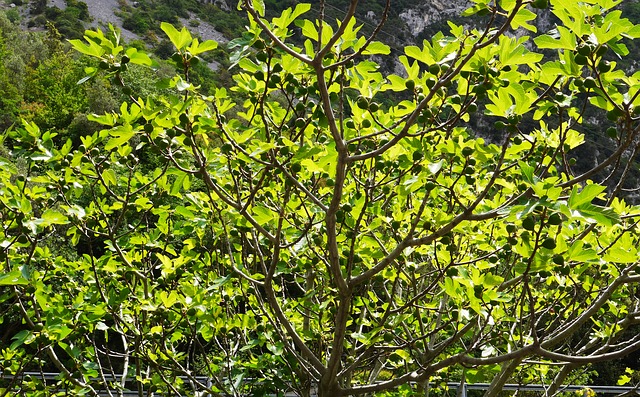Smart Strategies for Fruit Trees with Invasive Roots

Making sure that you have your fruit tree in the right location is paramount for a healthy tree. It’s common to wonder about the foundation of your house or other structures when planting your fruit tree. At planting a tree may appear tiny, but fast forward a few years into the future and you now have a 30-foot tall tree.
Knowing what type of fruit trees work best near your home will help provide comfort knowing that your house won’t ever be compromised by an invasive root system.
When Roots are Considered Invasive
When tree roots spread fast and easily regardless of soil conditions, it can be deemed invasive. An invasive root system can typically thrive in many conditions and is tough to get rid of. These types of root systems usually expand much further than the tree canopy.
An invasive root system doesn’t always mean its harmful or going to do some sort of damage. Some other things to consider is what makes up an invasive tree in general.
- Grows at a fast pace and can get to a large size tree in a short period of time
- Trees mature at an early age which allows them to produce seeds sooner
- Can produce large amounts of seed
- Flourish in shade or different conditions
- Grows on many different soil type
- Seeds remain viable for long periods of time like over a year
- Active seed dispersal mechanisms (birds, animals, wind)
Fruit Trees to avoid planting near your Home
- Figs
- Java Plum/Jamun
- Mango (If in a tropical environment)
- Mulberry
- Jamaican Cherry
- Jujube
- Carob
- Avocado
- Peach Trees
Consider These
- Banana
- Papaya
- Tropical Guava
- Annona (Sugar Apple, Atemoya, Soursop, Cherimoya)
- Dwarf Citrus
- Dwarf Stone Fruits (apples, cherries, plums, pears)
- Starfruit
- Paw Paws
- Kumquat
- Loquat
Strategies to Consider with Potentially Invasive Fruit Trees
If you’re a huge Fig lover, just because it’s a bit more of an aggressive tree, doesn’t mean you’re stuck with Papaya’s. When dealing with various fruit trees that may have more vigorous root systems than others, there are some strategies that can help. Here are a few things to consider when deciding to plant your fruit tree.
Environmental Factors
In tropical climates, it’s not uncommon to see trees like Mango or Sapodilla towering in the sky. These types of trees can get huge in a native environment. If you’re attempting to grow these types of trees outside of their native environment, they probably won’t grow as large or vigorous.
I’m growing various tropical fruit trees in growing zone 9b, but in a desert climate. Our extreme summers, lack of humidity, and light frosts tend to prevent these trees from becoming too large. I don’t see many 50-foot mango trees in the desert.
It’s important to consider your environmental factors when planting various types of trees because that will determine how vigorous your trees will grow. I have very minimal concerns planting most tropical fruit trees near my home or block walls, in fact doing so actually can help create a microclimate for your tree.

Pruning
Typically the root zone stays about the size of the canopy of the tree unless they’re not getting water or nutrients or are just very vigorous. The larger you allow your tree to get, the larger the roots are going to extend to keep the tree hydrated and fed. If you utilize pruning methods to keep trees smaller, it will slow the root growth down, and keep them more confined.
Watering
Shallow watering through sprinklers or frequent short duration’s of watering will keep the roots towards the surface of the soil. You may have noticed tree roots in a park or yard that have become exposed due to this type of watering.
When roots are traveling close to the surface, it increases the potential for those roots to cause problems to nearby structures. Watering your trees to depths of 3 feet or more at less frequent intervals will help the roots to stay deeper in the soil.
Another thing to consider is making sure that your trees are getting enough water. Roots will seek out water from pipes or other means if they aren’t getting enough through irrigation or rain.
RELATED POST: How to Water Fruit Trees in Hot Climates the Right Way
Root Barriers
If you decide that the only spot you have available is near a wall or your home or you’re just going to do it, consider using a root barrier. As long as it’s done properly, it can help prevent surface roots by encouraging them to grow down.
It’s important to utilize the root barrier at planting to at least a depth of a couple feet. Ensure that the barriers extend a few inches above grade for any potential surface roots. Here is a highly rated root barrier at an affordable cost. Click here or the image below.

Final Thoughts
As someone who has planted around 30 fruiting trees or plants on an urban lot around 1/5th of an acre, I’m not holding back when it comes to creating a food forest. The intention of this post isn’t to scare you from planting a fruit tree in your yard, but to help you make an informed decision on what and where to plant. It’s easy to get caught up in the fruit tree addiction, see my humorous take here, without always planning first.
Related Questions
How close can I plant a Fruit Tree to my House?
Unfortunately, there isn’t an exact distance that always works when determining how close to plant your fruit tree to your home. A lot depends on the type of fruit tree, how it’s cared for, and environmental conditions.
I’ve seen some fruit trees planted right up against a house for years without issue and heard of other types of trees causing problems from 20 feet away. A lot of it is going to depend on your comfort level, but having a better understanding of the type of fruit tree you want to grow will help you make your decision a lot easier.
What are Common signs of Root Damage?
Various weather conditions can impact the root structure. When trees are going through drought roots can constrict, while flooding can cause roots to expand. This change in the root diameter can cause soil shifts underneath the home that mimic settling.
Some potential signs of root damage on a home can be noticeable cracking in concrete. Floors may begin to buckle. Windows unexpectedly breaking. Vertical cracks may appear in foundation walls. Door frames can become uneven.
Is Root Damage covered by Homeowners Insurance?
Most homeowners insurance will not cover damage to your home from tree roots. Homeowners insurance covers things that happen quickly, unexpectedly, or accidental. Since tree root damage happens over a long period of time, it’s exempt from coverage.
A lot of times, neighbors tree can encroach others properties and cause the damage which further compounds the issue. It’s up to the homeowners to deal with any associated costs that can accrue from root damage to their property. So it’s up to you to determine how comfortable you are with where you’re planting your tree in relation to your home.
Please comment below on anything that you’ve enjoyed from this post or experiences with invasive fruit trees.
